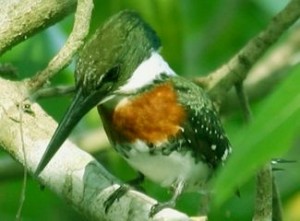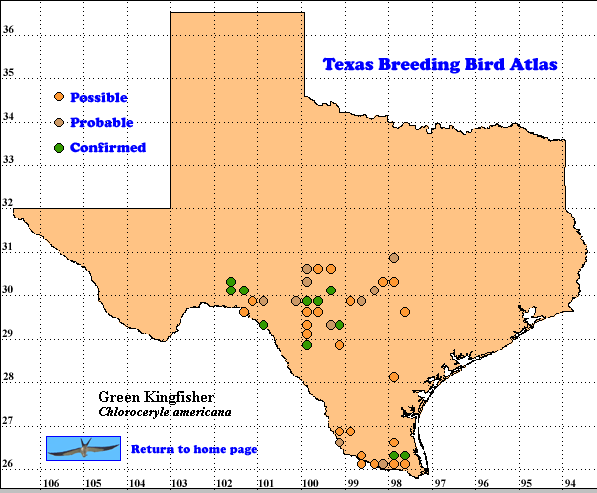The smallest of the three species of kingfishers breeding in the United States, the Green Kingfisher is about 30 cm (12 in) long overall with a bill about 47 mm (1.9 in) long. The heavy bill appears even larger in comparison to the rest of the body. These birds forage mostly for small fish, making shallow dives into clear water from low perches. Their diet also includes shrimp, aquatic insects and ants. Most of our knowledge of the life history of the Green Kingfisher comes from Central and South America (Moskoff 2002), suggesting the need for life history studies in Texas.
Continuing Green Kingfisher surveys are needed in Texas to document any population changes that may occur. The edges of population ranges are often the first place where changes are most apparent. In Arizona where all Green Kingfisher breeding evidence was found close to the Mexican border, a rapid decline began in 1996, with few observations of this species reported by the early 21st century (Corman 2005).
DISTRIBUTION. During the 1987-1992 field work seasons of the TBBA project, atlasers found breeding evidence for Green Kingfishers primarily along the rivers and their tributaries draining the Edwards Plateau: the Devil’s, Guadalupe, San Antonio and Nueces rivers, and along the Rio Grande River southeast from Val Verde County intermittently to the Gulf. The closest sites to the Gulf Coast north of the Rio Grande delta were in latilongs 26096 and 28096.
In the United States Green Kingfishers also have bred in or near Santa Cruz County in southeast Arizona (Corman 2005). This species also breeds through Mexico and Central America (Stiles and Skutch 1989, Howell and Webb 1995), and in South America from Trinidad and Tobago to Argentina and Chile (Am. Ornithol. Union 1998, Moskoff 2002).
SEASONAL OCCURRENCE .Green Kingfishers, year-round residents in Texas, breed from late February to late June, based on egg collection dates from March 4 to May 29 (Oberholser 1974). During colder than normal winters these birds may move south with their territories remaining unoccupied for as long as several years (Lockwood and Freeman 2004).
BREEDING HABITAT. Green Kingfishers breed in Texas from near sea level to 600 m (2000 ft) along clear rivers and streams (Oberholser 1974). In Arizona, atlasers found most breeding evidence along permanent or intermittent streams, ponds or pools with cottonwoods, willows and mesquite trees at their edges (Corman 2005). These kingfishers excavate a burrow in a dirt bank, 0.7-1 m (2-3 ft) long, 5 cm (2 in) high and 5.5 cm (2.2 in) wide with a small chamber for eggs at the end. The burrow is dug by both parents, using their bills to loosen dirt and their feet to kick it behind them. The entrance is usually concealed by overhanging vegetation (Moskoff 2002).
The female usually lays 5 (range 3-6) smooth, glossy, white, unmarked eggs on bare ground. Both parents incubate the eggs for 19-21 days. During this time the floor of the egg chamber becomes paved with compacted fish bones and scales and insect parts. Young birds take their first flights about 26-27 days after hatching and remain in their parents territory for about a month. Burrows may be reused another year (Oberholser 1974, Moskoff 2002).
STATUS. Green Kingfishers are uncommon within their range in Texas (Lockwood and Freeman 2004). This status is consistent with their limited habitat, non-colonial nature and sensitivity to severe winter weather in this state. Comparison of the TBBA map with that in Oberholser (1974) suggests this kingfisher still breeds in areas with breeding symbols on the earlier map as well as some with summer record symbols. However areas with only fall, winter or spring symbols are apparently not current breeding areas and may have represented post-breeding wandering. The population decline after World War II has apparently been reversed in the lower Rio Grande River valley (Oberholser1974, Moskoff 2002)
Text by Robert C. Tweit (2008)
Literature cited.
American Ornithologists’ Union. 1998. Checklist of North American birds, 7th ed. Am, Ornithol. Union, Washington, DC.
Corman, T. E. 2005. Green Kingfisher (Chloroceryle americana). In Arizona breeding bird atlas. pp. 268-269 (T. E. Corman and C. Wise-Gervais, eds.), University of New Mexico Press, Albuquerque.
Howell, S. N. G. and S. Webb. 1995. A guide to the birds of Mexico and northern Central America. Oxford University Press, New York.
Lockwood, M. W. and B. Freeman. 2004. The TOS handbook of Texas birds. Texas A&M University Press, College Station.
Moskoff, W. 2002. Green Kingfisher (Chloroceryle americana). In The birds of North America, No. 621 (A. Poole and F. Gill, eds.). The Birds of North America, Inc., Philadelphia, PA.
Oberholser, H. C. 1974. The bird life of Texas, University of Texas Press, Austin.
Stiles, F. G. and A. F. Skutch. 1989. A guide to the birds of Costa Rica. Cornell University Press, Ithaca, NY.

